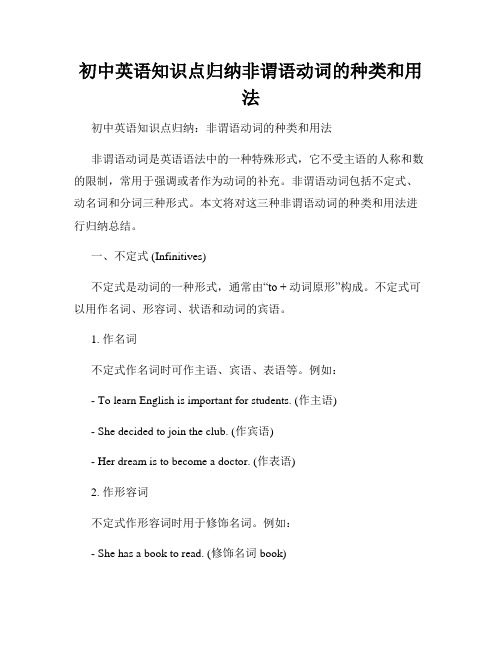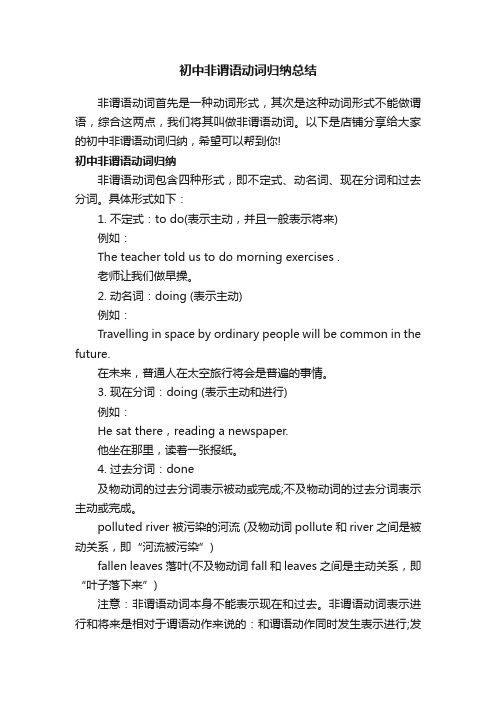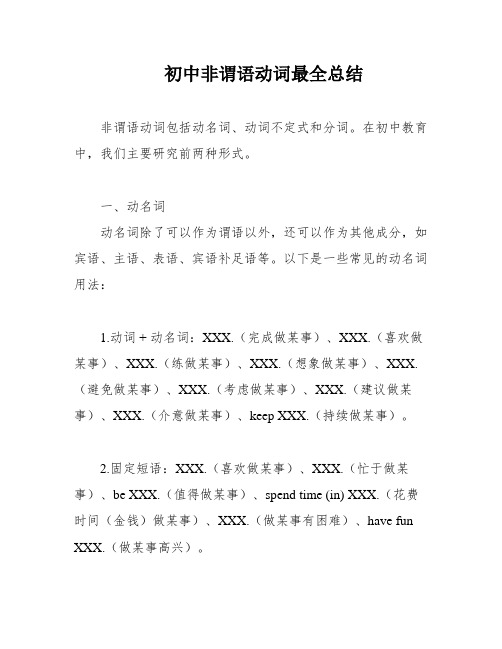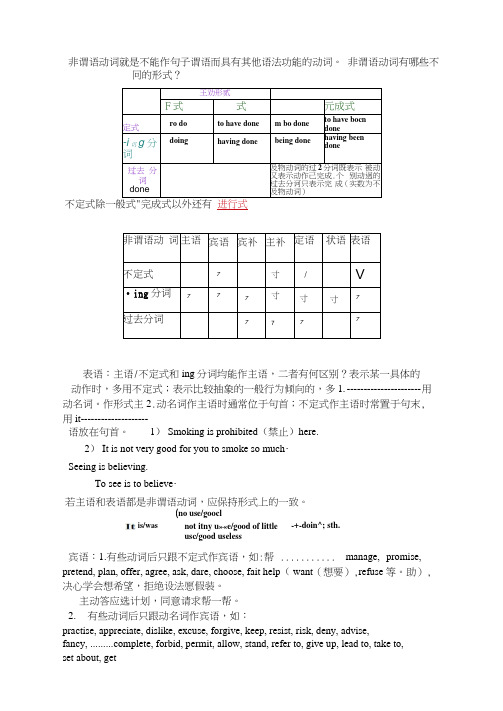初中英语语法知识—非谓语动词的分类汇编
初中非谓语动词知识点总结

非谓语动词(不定式、动名词)【考点概述】非谓语动词的本意是不能做谓语的词性,但是它具有谓语动词的性质。
非谓语动词是英语中特有的,在汉语中没有此概念。
所以在掌握此语法是比较困难的,在平时的备考之中应注意多多练习。
【考点释义】考点一:不定式(1)构成:to+动词原形(do)如:I like to swim.注意:不定式有省“to”的不定式和不省“to”的不定式两类,但多数以不省“to”的不定式为主。
如:I heard him (to)sing. 我听到他在唱歌。
(2)句法功能:1. 作主语在英语中为了避免头重脚轻,当不定式作主语时有时主语太长时我们用形式主语“it”来作“形式主语”,将真正主语移植动词不定时之后。
形式主语也就是我们所说的“不定式的复合结构”。
其构成为“It +be +(for/of sb) to do sth. 如:① It is very important ( us) to study English.= To study English is very important for us. 学英语对我们来说是很重要的② It is very kind ( you) to help me.= To help me is very kind of you. 你帮助我太好了。
当介词“of词“of”或“for”。
如果能够成主谓逻辑关系时我们使用介词“of”,反之则用介词“for”。
例如上述两个例子。
①It is very important (for us) to study English. Us is very important.(不成立)由于不能构成主谓关系,所以用介词“for”。
②It is very kind (of you) to help me. You are very kind. (成立)由于构成主谓关系,所以用介词“of”。
2. 作宾语当动词不定式作宾语是表示的是一种打算、希望、命令等。
最全的非谓语动词知识点总结

动词不定式和动名词作主语一,作主语⒈不定式作主语动词不定式作主语时,句子的谓语动词常用单数,其位置有以下两种:(1)把不定式置于句首, 不定式作主语侧重于将来特定的某一次, 如:To get there by bike will take us half an hour.(2)用it作形式主语,把真正的主语不定式置于句后,常用于下列句式中.如:①It+be+名词+to doIt's our duty to take good care of the old.②It takes sb + some time +to doHow long did it take you to finish the work③It+be+形容词+for sb +to doIt is difficult for us to finish writing the composition in a quarter of an hour.④It+be+形容词+of sb +to doIt is stupid of you to write down everything the teacher says.⑤It seems(appears)+形容词+to doIt seemed impossible to save money.在句型③中,常用表示客观情况的形容词,如:difficult, easy, hard, important, impossible, necessary 等;在句型④中,常用careless, clever, good, foolish, honest, kind, lazy, nice, right, silly, stupid, wise等表示赞扬或批评的词.在不定式前的sb,可看作其逻辑主语.这一句式有时相当于Sb is+形容词+to do句式,如:It's kind of you to help me with my English.=You are kind to help me with my English.⒉动名词作主语(1)把动名词置于句首, 侧重于经常性发生的动作. 如:Learning without practice is no good.动名词作主语时,也常用It句式.如:①It's +no good(no use, fun, a pleasure, a waste of time)+doing…It's no good reading in dim light.It's no use sitting here waiting.②动名词结构作主语,可以用名词或代词属格形式作逻辑主语.如: It's no use your pretending that you didn't know the rules.不定式、动名词、分词作表语的比较1、不定式和动名词作表语相当于名词作表语,表示主语的内容,主语和表语可以对调;1)动词不定式通常表示将来某一次,而动名词则表示经常性发生的动作。
初中英语语法之非谓语动词

初中英语语法之非谓语动词1.定义:动词除在句子中作谓语以外,还具有名词、形容词及副词的性质,在句中可作主语、表语、宾语、定语、状语和补语等,这就是动词的非谓语动词。
可分为三种:动词不定式、分词和动名词。
2.动词不定式:to + 动词原形。
1)一般式:主动语态:to do ,被动语态:to be + 动词过去分词2)进行式:主动语态:to be doing ,被动语态:无3)完成式:主动语态:to have +动词过去分词,被动语态:to have been +动词过去分词4)用法:A. 作主语:To learn a foreign language is not easy . = It’s not easy to learn a foreign language .B. 作表语:The most important thing is to finish the workon time .C. 作宾语:a. 动词+to do . He decided to buy a new watch .b. 动词+疑问词+to do I don’t k now where to put thebike .c. 动词+形式宾语+宾补+to do I find it important to learna second foreign language .D. 作补语:a. 动词+宾语+to do Tom asked me to show him the new shoes .b. 动词+宾语+不带to的动词He often saw Tom play football .E. 作状语:a. 表示目的:He went to Guangzhou to see his sons . He got up early in order to catch the first bus .b. 表示结果:He is too tired to walk any farther . They aren’t old enough to go to school .c. 表示原因:He is sorry to hear that . I am glad to see you .F.作定语:I have something to tell you . I want to buy something to eat .5)动词不定式to 的省略:A. 在感官动词feel,hear,see,watch,notice 及使役动词have,let,make等后面要省to,但在变被动语态时要还原不定式to.I often saw him go out of the room .——He was often seen to go out of the room by me .B.在had better,would rather,do nothing but等后面常省to.6)动词不定式的否定形式:not + to do ,有时也可以用-never + to do 结构。
非谓语动词知识点总结

非谓语动词知识点总结非谓语动词是英语语法中的一个重要知识点,它可以用来修饰主语或宾语,增强句子的表达力和信息量。
在本文中,我将详细介绍非谓语动词的用法和一些常见的形式。
希望通过本文的阅读,读者能够更好地理解和运用非谓语动词,提高自己的英语写作水平。
一、非谓语动词的定义和分类非谓语动词是指在句子中充当动词的成分,但不具备谓语的功能。
它不受主语的人称和数的限制,也不受时态的影响。
根据其形式和功能的不同,非谓语动词可以分为动名词、不定式和分词三种形式。
1. 动名词(Gerund)动名词是动词加上-ing形式构成的名词,常用作主语、宾语、表语、宾补等。
例如:- Smoking is harmful to health.(吸烟对健康有害)- I enjoy swimming in the sea.(我喜欢在海里游泳)- His hobby is playing basketball.(他的爱好是打篮球)2. 不定式(Infinitive)不定式是动词的原形加上to构成的形式,常用作动词、形容词或名词的补语。
例如:- He wants to buy a new car.(他想买一辆新车)- I have a lot of work to do.(我有很多工作要做)- The book is too heavy to carry.(这本书太重,无法携带)3. 分词(Participle)分词是动词的-ing形式(现在分词)或-ed、-en等形式(过去分词)构成的形容词,常用作定语、状语或补语。
例如:- The running water is very clear.(流动的水非常清澈)- The broken vase has been repaired.(打破的花瓶已经修好了)- We were surprised by the exciting news.(令人兴奋的消息让我们感到惊讶)二、非谓语动词的用法非谓语动词在句子中具有独立的语法功能,可以用来修饰名词、代词、动词、形容词和副词等,以及构成复合句的各种从句。
初中英语知识点归纳非谓语动词的种类和用法

初中英语知识点归纳非谓语动词的种类和用法初中英语知识点归纳:非谓语动词的种类和用法非谓语动词是英语语法中的一种特殊形式,它不受主语的人称和数的限制,常用于强调或者作为动词的补充。
非谓语动词包括不定式、动名词和分词三种形式。
本文将对这三种非谓语动词的种类和用法进行归纳总结。
一、不定式 (Infinitives)不定式是动词的一种形式,通常由“to + 动词原形”构成。
不定式可以用作名词、形容词、状语和动词的宾语。
1. 作名词不定式作名词时可作主语、宾语、表语等。
例如:- To learn English is important for students. (作主语)- She decided to join the club. (作宾语)- Her dream is to become a doctor. (作表语)2. 作形容词不定式作形容词时用于修饰名词。
例如:- She has a book to read. (修饰名词book)不定式作状语时可以表示目的、结果、原因、条件等。
例如:- He went to the park to play basketball. (表示目的)- She studies hard to get good grades. (表示结果)- We woke up early to catch the train. (表示原因)- I need your help to finish the project. (表示条件)4. 作动词的宾语不定式可以作为动词的宾语,常见的动词有want, hope, like, love, hate等。
例如:- She wants to be a teacher when she grows up.- They hope to visit China next year.二、动名词 (Gerunds)动名词是以-ing结尾的动词形式,它可以作主语、宾语、表语、定语或者状语。
中学英语非谓语动词讲解

中学英语非谓语动词讲解非谓语动词是指动词的非时态形式,它包括不定式、动名词和分词(包括现在分词和过去分词)。
非谓语动词可以作主语、宾语、表语、定语、状语等成分,具有多种语法功能和句法结构。
在中学英语中,非谓语动词被广泛使用,掌握非谓语动词的用法对于学生的语言表达能力和阅读理解能力提升非常重要。
一、不定式(Infinitives)1. 不定式作主语:- To learn a foreign language is beneficial to your future.- It's important to exercise regularly.2. 不定式作宾语:- I want to go shopping after school.- He promised to finish the report by tomorrow.3. 不定式作表语:- Her dream is to become a doctor.- The most important thing is to believe in yourself.4. 不定式作定语:- She has a lot of books to read during the summer vacation.- This is a good place to have a picnic.5. 不定式作状语:- I wake up early to catch the bus.- She studied hard to pass the exam.二、动名词(Gerunds)1. 动名词作主语:- Swimming is my favorite sport.- Dancing helps improve coordination.2. 动名词作宾语:- She enjoys reading novels.- He hates doing the dishes.3. 动名词作表语:- His hobby is playing the piano.- The key to success is working hard.4. 动名词作定语:- I have a meeting with my boss tomorrow morning. - The running water sounds relaxing.5. 动名词作状语:- She left the room, crying loudly.- He drove to work, listening to music.三、分词(Participles)1. 现在分词作定语:- The exciting movie kept us on the edge of our seats. - The running boy bumped into a lady.2. 现在分词作状语:- Smiling happily, she accepted the gift.- With his homework finished, he went to bed.3. 过去分词作定语:- The broken chair needs to be repaired.- The lost dog was found by its owner.4. 过去分词作状语:- Inspired by her teacher, she decided to pursue a career in art.- Exhausted from the long journey, they went straight to bed.总结起来,中学英语非谓语动词的用法主要包括不定式、动名词和分词。
初中英语知识归纳总结——非谓语动词

初中英语知识归纳总结——非谓语动词非谓语动词(一)教学重点动词不定式在英语中,不充当句子谓语的动词,叫作非谓语动词。
由于非谓语动词不受主语的限制,没有时态和语态,所以又叫非限定动词。
非限定动词有三种形式:动词不定式;动名词和分词。
1、动词不定式(1)动词不定式的构成和性质动词不定式是一种非谓语动词,所谓非谓语动词就是不能作谓语的动词。
正因为如此,它不受主语的人称和数的限制,没有人称和数的变化,但它具有动词的某些特征,可以带宾语和状语构成不定式短语。
其构成是:“to + 动词原形”,否定式是“not to +动词原形”。
to是不定式符号,无词义。
(2)动词不定式的用法动词不定式除了不能作谓语外,可以作主语、表语、宾语、宾语补足语、定语和状语。
①作主语To learn English well is not easy.To drive fast is quite dangerous.不定式作主语时常常用it作形式主语,不定式放在谓语之后以上两个例句可以写成:It is not easy to learn English well.It is quite dangerous to drive fast.这种用法可以归纳成这样一个句型:It is (not) + 形容词+ (for sb.) to do sth.It is very expensive for me to buy a car.It is very difficult for a child to do that job.有些形容词之后跟of + 名词(代词宾语)+不定式。
如:It is very kind of you to say so.It is very good of you to come.②作表语。
如:My job is to teach English.The first thing is to ring him up.③作宾语。
初中非谓语动词最全总结[1]
![初中非谓语动词最全总结[1]](https://img.taocdn.com/s3/m/2adf2314ce84b9d528ea81c758f5f61fb6362876.png)
非谓语动词总结非谓语动词: 即, 在句子中除了充当谓语以外成分的词。
它可以分为动名词, 动词不定式, 分词。
初中着重讲前两种。
一. 后面可跟动词的ing形式的情况1.动词.finis.doin.sth.完成做某事;enjo.doin.sth.喜欢做某事;practic.doin.sth.练习做某事;imagin.doing,想象做某事;avoi.doin.sth.避免做某事;conside.doin.sth.考虑做某事;sugges.doin.sth.建议做某事;min.doin.sth.介意做某事.kee.doin.sth.持续做某事2.固定短语: feel like doing sth.喜欢做某事;be busy doing sth.忙于做某事;be worth doing 值得做某事;spend time (in) doing sth.花费时间(金钱)做某事; have difficult/trouble in doing sth做某事有困难;have fun doing.做某事高兴3.介词后(on, in, of, about, at, with, without, for, from, up, by 等)如: b.goo.a.doin.sth.;than.yo.fo.doin.sth.;giv.u.doin.sth.;sto.sb.fro.doin.sth.;d.wel.i.doin.sth.;b.afrai.o.doin.sth.;b.intereste.i.doin.sth.;b.prou.of;instea.of;b.fon.of4.to作介词的情况loo.forwar.t.doin.sth期望做某事.prefe.doin.sth.t.doin.sth与…相比较更喜欢….pa.attentio.t.doing注意做某事.be/e.t.doin.sth.习惯于做某事;mak..contributio.to为…做贡献二. 后面可跟动词的不定式形式的情况1.动词: agre.t.do同意去做;affor.t.do买得起;decid.t.do决定去做某事;hop.t.do希望去做;wis.t.do希望去做;fai.t.do做某事失败去;pla.t.do打算去做;preten.t.do假装去做.refus.t.do拒绝去做;woul.lik.t.do想要去做;wan.t.do想要去做某事;lear.t.d.学做;prefe.t.d.sth.喜欢(爱)做某事;sb.see.t.d.sth好像做某事;want/woul.lik.t.d.sth.想做……;use.t.d.sth.过去常做某事2.句型.allo.sb.t.d.sth.允许某人去做某事aske.sb.(not.t.d.sth.叫某人做事某事(叫某人不要去做某事)tel.sb.(not.t.d.sth.叫某人去(不要)做某事follo.sb.t.d.sth.跟随某人去做某事ge.sb.t.d.sth.让某人做某事war.sb.(not.t.d.sth. 警告某人做某事(或不要做某事)b.amaze.t.d.sth.对做某事感到惊讶b.afrai.t.d.sth.害怕做某事b.excite.t.d.sth.对做……感到兴.b.frightene.t.d.sth.害怕去做某事b.glad/happ.t.d.sth.高兴去做某事be/get ready to do sth.准备做某事b.sorr.t.d.sth.对做某事感到抱...b.surprise.t.d.sth.对做某事感到惊奇can’.wai.t.d.sth.迫不急待地去做某事get/hav..chanc.t.d.sth.得到一个做某事的机会It’..adj.+(fo.sb..t.d.sth.做某事(对某人来说)怎么样It’.+adj.+(o.sb..t.d.sth.I.take.sb.som.time/mone.t.d.sth.花费某人多长时间做某事It’.bes.fo.sb.t.d.sth.对某人来说做某事是最好的It’.tim.fo.sb.t.d.sth.是某人做某事的时候了too…(for sb.) to …太…以致不能… =not… enough to do =so…that prefe.t.d.sth.rathe.tha.d.sth.宁愿……而不愿……(常考)something to eat/drink 一些吃/喝的东西(动词不定式放在something 等后)Sth.i.hard/difficult/eas.t.d.做好某事很难/容易tak.turn.t.d.sth.轮流做……Ther.i.n.tim.(fo.sb..t.d.sth.对(某人来说)没时间做某事了Ther.i.n.nee.(fo.sb..t.d.sth.对某人来说没必要做某事try/d.one’.bes.t.d.sth.尽力去做某事3.动词不定式与疑问代词和疑问副词的连用。
初二英语非谓语动词知识点

初二英语非谓语动词知识点非谓语动词是英语中的一个重要语法现象,它由动词的原形或动词的ing形式构成,常常在句子中起到名词、形容词或副词的功能。
非谓语动词包括不定式、动名词和现在分词,它们具有自己的语法特点和用法。
下面将介绍初二英语中非谓语动词的常见知识点。
一、不定式(Infinitive)不定式是由动词的原形加上to构成,它可以作为名词、形容词或副词使用。
1. 作为名词:不定式作为名词时,常用于句子的主语、表语、宾语以及介词的宾语等。
例句:- To learn a foreign language is beneficial for personal development.学习一门外语有助于个人发展。
- My dream is to become a successful writer.我的梦想是成为一名成功的作家。
- He asked me to help him with the assignment.他要求我帮他完成作业。
2. 作为形容词:不定式作为形容词时,可以修饰名词或代词,表示目的、原因、结果等。
例句:- I need a book to read during my vacation.我需要一本可以在假期阅读的书。
- This is a difficult problem to solve.这是个难以解决的问题。
- She was too excited to sleep.她太兴奋无法入睡。
3. 作为副词:不定式作为副词时,可以修饰动词、形容词或副词,表示目的、结果等。
例句:- He studies hard to get good grades.他努力学习以取得好成绩。
- She spoke loudly to make herself heard.她大声说话以让自己被听到。
- We drove carefully not to cause any accidents.我们小心驾驶,以免造成事故。
初中非谓语动词归纳总结

初中非谓语动词归纳总结非谓语动词首先是一种动词形式,其次是这种动词形式不能做谓语,综合这两点,我们将其叫做非谓语动词。
以下是店铺分享给大家的初中非谓语动词归纳,希望可以帮到你!初中非谓语动词归纳非谓语动词包含四种形式,即不定式、动名词、现在分词和过去分词。
具体形式如下:1. 不定式:to do(表示主动,并且一般表示将来)例如:The teacher told us to do morning exercises .老师让我们做早操。
2. 动名词:doing (表示主动)例如:Travelling in space by ordinary people will be common in the future.在未来,普通人在太空旅行将会是普遍的事情。
3. 现在分词:doing (表示主动和进行)例如:He sat there,reading a newspaper.他坐在那里,读着一张报纸。
4. 过去分词:done及物动词的过去分词表示被动或完成;不及物动词的过去分词表示主动或完成。
polluted river 被污染的河流 (及物动词pollute和river之间是被动关系,即“河流被污染”)fallen leaves 落叶(不及物动词fall和leaves之间是主动关系,即“叶子落下来”)注意:非谓语动词本身不能表示现在和过去。
非谓语动词表示进行和将来是相对于谓语动作来说的:和谓语动作同时发生表示进行;发生在谓语动作之后表示将来非谓语动词的作用非谓语动词除去不能做谓语之外,其它所有成分都可以做。
具体如下。
1. 不定式:做主语、宾语、表语、定语、状语和补语。
To learn a foreign language is difficult .(作主语)学会一门外语是很难的。
It’s easy to see their aunt.(作真正主语,it做形式主语)很容易见到他们的姑姑。
Tom wanted to have a cup of beer.(作宾语)汤姆想要喝杯啤酒。
非谓语动词的分类

非谓语动词的分类非谓语动词是指在句子中不具备谓语作用的动词形式,常见的有动词不定式、动名词和分词。
它们在句子中具有名词、形容词或副词的功能。
以下将介绍非谓语动词的分类和常见用法。
一、动词不定式(infinitive)动词不定式是非谓语动词的一种形式,主要有两种形式:一般式和完成式。
一般式的动词不定式前不带to,而完成式的动词不定式则在动词的前面加上to。
1. 一般式动词不定式动词不定式的一般式常用于以下几种情况:1.1 作为宾语补足语例如:He wants to study medicine.(他想学医。
)I promise to help you.(我承诺会帮助你。
)1.2 作为表语例如:Her dream is to become a successful writer.(她的梦想是成为一名成功的作家。
)The most important thing is to stay positive.(最重要的是保持积极的心态。
)1.3 作为定语例如:This is the best way to solve the problem.(这是解决问题的最好方法。
)I need a pen to write the letter.(我需要一支笔来写信。
)2. 完成式动词不定式完成式动词不定式主要用于表示动作发生在谓语动词之前,并具有完成的含义。
常见的用法有:2.1 表示目的例如:I bought this book to improve my English.(我买这本书是为了提高英语水平。
)He went to the store to buy some groceries.(他去商店买一些杂货。
)2.2 表示推测例如:She seems to have forgotten about the appointment.(她似乎忘记了约会。
)He appears to be in a hurry.(他看起来很着急。
初中知识点归纳非谓语动词的分类与形式

初中知识点归纳非谓语动词的分类与形式非谓语动词是指在句子中作状语、定语或补语,不具备时态和人称的动词形式。
初中阶段涉及的非谓语动词主要包括动词不定式、动名词和分词。
本文将对非谓语动词的分类与形式进行归纳。
一、动词不定式(infinitive)动词不定式是非谓语动词中最常见的形式之一,它由“to + 动词原形”构成,具有名词和动词的双重性质。
1. 主动形式主动形式的动词不定式可以作为句子的主语、宾语、表语、宾语补足语等。
例如:- To learn English well is my goal. (主语)- He likes to play football. (宾语)- Her dream is to become a doctor. (表语)- They want to buy a new car. (宾语补足语)2. 被动形式被动形式的动词不定式表示动作的承受者,常用于被动语态中。
它由“to be + 过去分词”构成。
例如:- The job needs to be done quickly. (承受者为the job)- He hopes to be invited to the party. (承受者为he)3. 否定形式否定形式的动词不定式在“to”之后添加“not”,表示否定的意义。
例如:- I decided not to go to the party. (否定形式作为不定式的一部分)二、动名词(gerund)动名词是以动词ing形式充当名词的一种形式,具有名词的特点,可以作为主语、宾语、表语、定语、宾语补足语等。
1. 作主语动名词作为句子的主语时,常用单数形式。
例如:- Reading is my favorite hobby.- Swimming is good for health.2. 作宾语动名词作为某些动词的宾语,表示动作的客体。
例如:- I enjoy playing basketball.- He avoids eating junk food.3. 作表语动名词作为表语时,通常表示状态或特征。
初中英语知识点归纳非谓语动词的分类与用法

初中英语知识点归纳非谓语动词的分类与用法初中英语知识点归纳:非谓语动词的分类与用法非谓语动词是指不能作谓语的动词形式,包括动词不定式(infinitive)、动名词(gerund)和现在分词(present participle)等形式。
在英语语法中,非谓语动词作为名词、形容词或副词的补语,经常出现在句子中起到修饰或补充说明的作用。
下面将对非谓语动词的分类和用法进行归纳总结。
一、动词不定式(infinitive)1. 主动形式的动词不定式作主语、宾语、表语等。
示例:- To swim in the sea is my favorite activity.(在海里游泳是我最喜欢的活动。
)- I want to be a doctor.(我想成为一名医生。
)2. 不定式的被动形式常常用于被动语态、感官动词和某些特定的动词后作宾语。
示例:- The book is easy to understand.(这本书很容易理解。
)- I heard him singing in the shower.(我听见他在淋浴时唱歌。
)3. 不定式的完成形式表示在谓语动词之前发生的动作。
示例:- I'm happy to have finished my homework.(我很高兴已经完成了作业。
)二、动名词(gerund)1. 动名词作主语,常用于表示习惯、通用事实、抽象概念等。
示例:- Swimming is good for your health.(游泳对健康有益。
)2. 动名词作宾语,常与动词一起构成一些固定搭配。
示例:- I enjoy playing basketball with my friends.(我喜欢和朋友们打篮球。
)3. 动名词作介词的宾语,常用于介词后。
示例:- He is good at singing.(他擅长唱歌。
)三、现在分词(present participle)1. 现在分词作定语,修饰名词或代词。
初中英语语法-非谓语动词

初中英语语法-⾮谓语动词⾮谓语动词⼀.定义:⾮谓语动词是指在句⼦中不是谓语的动词,即动词的⾮谓语形式。
约占中考10%。
⼆.分类:动词不定式、v-ing形式和过去分词。
1.动词不定式1)构成:(not) to do / (not) do2)句法功能:(1)作主语:To finish the work in ten minutes is very hard. ⼗分钟之内完成这项⼯作是很难的。
To lose your heart means failure. 灰⼼意味着失败。
动词不定式短语作主语时,常⽤it作形式主语,真正的主语不定式置于句后,例如上⾯两句可⽤如下形式:It is very hard to finish the work in ten minutes. ⼗分钟之内完成这项⼯作是很难的。
It means failure to lose your heart. 灰⼼意味着失败。
常⽤句式:It+be+名词+to do sth.It takes sb.+some time+to do sth.It+be+形容词+of /forsb +to do sth.常⽤careless, clever, good, foolish, honest, kind, lazy, nice, right, silly, stupid, wise,等表⽰赞扬或批评的形容词,不定式前的sb.可作其逻辑主语。
区别:当使⽤for时,句中形容词修饰的是不定式;It’s necessary for you to study hard .(necessary 修饰to study hard,表⽰学习努⼒是有必要的)⽽⽤of时,句中形容词修饰逻辑主语。
It’s fo olish of him to do it .(foolish 修饰逻辑主语him)(2)作表语:Her job is to clean the hall. 她的⼯作是打扫⼤厅。
初中英语语法大全——非谓语动词(共24张PPT)

知识归纳 常用it作形式主语的句式 It is no use/ good doing..做...是没有用的不好的。 It is a waste of time doing...做..是浪费时间的。 It is useful/ enjoyable/ tiring doing...
做...是有用的/ 令人高兴的/累人的
(6)不定式作状语
①不定式作状语主要表示目的等。表示目的时常位于句首,表 示原因和结果时常位于句尾。 eg: To arrive there on time, I got up one hour earlier than usual. eg: In ancient China, food was stored with ice to kee p it fresh.
常接动名词作宾语的(短语)动词
enjoy喜欢
finish完成
practise练习
suggest建议
mind介意
avoid避免
admit承认
consider考虑
give up放弃
look forward to盼望
imagine想象
be busy忙于 put off推迟
feel like想要
be worth值得
(4)不定式作宾语补足语
eg: Lucy asked him to turn down the radio. eg: Mr. White persuaded Tom not to smoke any more. eg: I sat near her and heard her sing the new song. eg: The peaceful music in the CD made the students feel relax.
初中非谓语动词知识点总结

初中非谓语动词知识点总结非谓语动词是指除了谓语动词之外的动词形式,包括不定式、动名词和分词。
掌握非谓语动词的用法对于初中生来说非常重要。
下面是初中非谓语动词的知识点总结:1.不定式动词(Infinitives)1.不定式动词(Infinitives)1.不定式动词(Infinitives)1.不定式动词(Infinitives)不定式通常由"to + 动词原形"构成,例如:to read、to write。
不定式可以用作主语、宾语、表语、定语和状语等,例如:"To learn English is my goal."(主语)、"I want to be a doctor."(宾语)。
不定式还可以与一些动词连用,例如:agree to、decide to。
2.动名词(Gerunds)2.动名词(Gerunds)2.动名词(Gerunds)2.动名词(Gerunds)动名词是以-ing结尾的动词形式,例如:reading、writing。
动名词可以用作主语、宾语、表语、定语和状语等,例如:"___."(主语)、"I enjoy swimming."(宾语)。
动名词还可以与一些动词连用,例如:enjoy、keep。
3.分词(Participles)3.分词(Participles)3.分词(Participles)3.分词(Participles)分词有现在分词和过去分词两种形式。
现在分词以-ing结尾,过去分词通常以-ed或其他形式结尾,例如:running、broken。
现在分词可以表示主动或进行的动作,过去分词可以表示被动或完成的动作,例如:"The dog barking is ___."(主动)、"The window ___."(被动)。
分词可以用作定语和状语等,例如:___"(定语)、"Feeling tired。
初中非谓语动词最全总结

初中非谓语动词最全总结非谓语动词包括动名词、动词不定式和分词。
在初中教育中,我们主要研究前两种形式。
一、动名词动名词除了可以作为谓语以外,还可以作为其他成分,如宾语、主语、表语、宾语补足语等。
以下是一些常见的动名词用法:1.动词 + 动名词:XXX.(完成做某事)、XXX.(喜欢做某事)、XXX.(练做某事)、XXX.(想象做某事)、XXX.(避免做某事)、XXX.(考虑做某事)、XXX.(建议做某事)、XXX.(介意做某事)、keep XXX.(持续做某事)。
2.固定短语:XXX.(喜欢做某事)、XXX.(忙于做某事)、be XXX.(值得做某事)、spend time (in) XXX.(花费时间(金钱)做某事)、XXX.(做某事有困难)、have fun XXX.(做某事高兴)。
3.介词后(on。
in。
of。
about。
at。
with。
without。
for。
from。
up。
by等):be good at doing sth.(擅长做某事)、thank you for doing sth.(感谢做某事)、give up XXX.(放弃做某事)、XXX.(阻止某人做某事)、do well in doing sth.(做某事做得好)、XXX.(害怕做某事)、be XXX.(对做某事感兴趣)、be proud of(以…为自豪)、instead of(代替)、be fond of(喜爱)。
4.to作介词:look forward to doing sth.(期望做某事)、XXX.(与…相比较更喜欢…)、pay n to doing sth.(注意做某事)、be/get used to doing sth.(惯于做某事)、XXX(为…做贡献)。
二、动词不定式动词不定式通常作为动词的宾语、宾语补足语、主语、表语、定语等。
以下是一些常见的动词不定式用法:1.动词 + 不定式:decide to do sth.(决定做某事)、want to do sth.(想做某事)、XXX.(希望做某事)、try to do sth.(尝试做某事)、fail to do sth.(未能做某事)、XXX.(拒绝做某事)、promise to do sth.(承诺做某事)、manage to do sth.(设法做某事)。
完整版非谓语动词知识点总结

非谓语动词就是不能作句子谓语而具有其他语法功能的动词。
非谓语动词有哪些不冋的形式?王劝形贰F 式式元成式定式ro do to have done m bo done to have bocn done-i 讥g 分词doinghaving donebeing donehaving been done过去 分词done及物动词的过2分词既表示 被动又表示动作己完成.个 别动迥的过去分诃只表示完 成(实数为不及物动词)不定式除一般式"完成式以外还有 进行式非谓语动 词 主语 宾语 宾补 主补 定语 状语 表语不定式7寸/V•ing 分词 777寸寸寸7 过去分词7 777表语:主语/不定式和ing 分词均能作主语,二者有何区别?表示某一具体的 动作时,多用不定式;表示比较抽象的一般行为倾向的,多1. ---------------------- 用 动名词。
作形式主2.动名词作主语时通常位于句首;不定式作主语时常置于句末, 用it-------------------- 语放在句首。
1) Smoking is prohibited (禁止)here.2) It is not very good for you to smoke so much ・ Seeing is believing.To see is to believe ・宾语:1.有些动词后只跟不定式作宾语,如:帮 ........... manage, promise, pretend, plan, offer, agree, ask, dare, choose, fait help ( want (想要),refuse 等。
助), 决心学会想希望,拒绝设法愿假装。
主动答应选计划,同意请求帮一帮。
2. 有些动词后只跟动名词作宾语,如:practise, appreciate, dislike, excuse, forgive, keep, resist, risk, deny, advise, fancy, ......... c omplete, forbid, permit, allow, stand, refer to, give up, lead to, take to, set about, get若主语和表语都是非谓语动词,应保持形式上的一致。
初中英语语法 非谓语动词总结

初中英语语法非谓语动词总结非谓语动词主要包括不定式、动名词和现在分词。
为了区分这三种不同的非谓语动词的用法和含义,我们将分别从三种非谓语动词在句子中做主语、宾语、宾语补足语、定语、状语、表语以及一些特殊结构句型等角度来区分其用法和细微含义。
1.不定式和动名词作主语的区别(1)动名词作主语通常表示抽象动作;而不定式作主语表示具体动作。
Smoking is prohibited(禁止)here.这里禁止抽烟。
(抽象)It is not very good for you to smoke so much.你抽这么多烟对你身体很不好。
(具体)(2)动名词作主语时,通常用以表示一件已知的事或经验。
不定式短语通常用来表示一件未完成的事或目的。
Climbing mountains is interesting.爬山很有趣。
(经验)Driving a car during the rush hour is tiring.在高峰时刻开车令人厌烦。
(经验) (3)不定式做主语,一般用it当形式主语,把作主语的不定式短语后置。
It took me only five minutes to finish the job.2.不定式、动名词和分词作表语的区别(1)不定式作表语1)不定式作表语一般表示具体动作,特别是表示将来的动作。
To do two things at a time is to do neither.--次做两件事等于未做。
What I would suggest is to start work at once.我的建议是立刻开始干。
2)如果主语是不定式(表示条件),表语也是不定式(表示结果)。
To see is to believe.百闻不如一见。
To work means to earn a living.工作就是为了生活。
3)如果主语是以aim,duty,hope,idea,happiness,job,plan,problem,purpose,thing,wish等为中心的名词,或以what引导的名词性从句,不定式作表语是对主语起补充说明作用。
- 1、下载文档前请自行甄别文档内容的完整性,平台不提供额外的编辑、内容补充、找答案等附加服务。
- 2、"仅部分预览"的文档,不可在线预览部分如存在完整性等问题,可反馈申请退款(可完整预览的文档不适用该条件!)。
- 3、如文档侵犯您的权益,请联系客服反馈,我们会尽快为您处理(人工客服工作时间:9:00-18:30)。
一、选择题1.—Let him __________us to learn English, OK? —Great!A.Helps B.to help C.help D.helping2.Our parents won't allow us _____ in the river alone.A.swimB.to swimC.swimmingD.swam3.When he saw the photo, he couldn’t stop ________ her sta y in London.A.think of B.to think of C.thought of D.thinking of 4.— Mr. Wang, I have trouble __________ the text.— Remember __________ it three times at least.A.to understand;readingB.understanding;to readC.understanding;readingD.to understand;to read5.—What do you think is the most important rule for a drive?—He or she must avoid_______ after drinking.A.driving B.no driving C.not to drive D.to drive6.We should do what we can _________ animals in danger.A.save B.to save C.saving D.saved7.(2016天津中考)I wanted to see the Beijing Opera, so Lingling offered me to watch an opera.A.took B.takes C.to take D.taking8.I used to . But now I get used to doing everything. I’m successful at last.A.give up; keeping B.giving up; keepingC.giving up; keep D.give up; keep9.The opera is very difficult. I hope ________ more next time.A.understand B.understanding C.to understand D.understood10.It usually takes him half an hour ________ the homework.A.finish B.finishing C.to finish11.--- Linda, thanks for____ me.--- ________A.help, You’re welcome.B.helps, No thanks.C.helping, No thanks. D.helping, You’re welcome.12.During the mid-autumn festival, family members often gather together _______ а meal, admire the moon and enjoy the moon cakes.A.share B.to share C.sharing D.shared13.—You don’t know what great difficulty I had ________ to get the two tickets.—But the film is really worth _________ twice.A.managing; seeing B.to manage; seeing C.managing; being seen D.managed; to see14.—Let's think about _______ A Bite of China tonight?—That sounds good!A.watch B.watching C.to watch D.watches 15.Class Four plans________ a meeting about the school art festival tomorrow. A.have B.to have C.has D.are having 16.When I walked past the park, I saw some old people ________ Chinese Taiji. A.does B.did C.doing D.are doing 17.—Why are you so excited today?—We were told ____ a picnic this weekend.A.have B.to haveC.having D.had18.How lucky Peter was! Some policemen arrived in time and __________ him out. A.managed to help B.tried to help C.succeeded to help D.tried helping 19.We should do everything we can________the endangered birds.A.protect B.protecting C.to protect D.protected 20.— Have you considered ________Robert some help?— Yeah. I have already promised to lend him some money.A.give B.to give C.giving D.to giving 21.Thank you for________us so well, Mr. Wang.A.teaches B.teaching C.teach D.to teach 22.—This physics problem is too difficult. Can you show me ________, Wang Lin?—Sure.A.what to work it out B.what to work out itC.how to work it out D. how to work out it23.Tom plans to Australia this summer but I would like America.A.to go, visiting B.to go, to visit C.going, to visit 24.—So beautiful flowers! I can’t decide _____ for m y mom.—For Mother’s Day, it can’t be better to take some carnations(康乃馨).A.when to choose B.which to choose C.how to choose 25.—It’s too hot today. I decided working and have a drink.A.stop B.stopping C.to stop26.I’m looking forward to _________into a good university.A.get B.got C.getting D.gets 27.Our class teacher told us ________ in the playground now for it is wet now.A.to play B.not to play C.played D.don’t play28.—What about_____________?—That’s a good idea,A.go shopping B.going shop C.going shopping D.go to shop【参考答案】***试卷处理标记,请不要删除一、选择题1.C解析:C【解析】【分析】【详解】句意:——让他帮我们学英语,好吗?——太好了!考查固定句型,A. helps动词三单形式;B. to help 动词不定式;C. help动词原形;D. helping现在分词。
根据“let sb do sth让某人做某事”,故选C。
2.B解析:B【解析】句意:我们的父母不允许我们单独去河里游泳。
A. swim动词原形;B. to swim动词不定式;C. swimming分词形式;D. swam过去式。
Allow sb to do sth允许某人做某事。
故答案选B。
点睛:接动词不定式作宾语补足语的常见动词:advise. 建议;allow 允许;ask 请(叫);encourage.鼓励;expect 期望;help. 帮助;invite. 邀请; like 喜欢;need需要;order命令;prefer. 宁愿teach .教;tell 告诉;want. 想;warn. 警告;wish希望等。
3.D解析:D【解析】【分析】【详解】句意:当他看到那张照片时,他停不住的想起他在伦敦的逗留。
考查固定搭配。
think of想起,想到;to think of动词不定式;thought of过去式;thinking of动名词。
can’t stop doing sth不能停止做某事,故选D。
4.B解析:B【解析】【分析】【详解】句意:——王老师,我理解课文有困难。
——记住至少读三遍。
考查固定短语。
understanding动名词形式;reading动名词形式;to understand动词不定式;to read动词不定式。
have trouble (in) doing sth.为固定搭配,意为“做某事有困难”,故第一个空应填入动名词understanding,A、D选项可排除。
remember to do sth.意为“记得去做某事”,remember doing sth.意为“记得做过某事”。
根据句意可知,“读三遍课文”这一动作还未做过,故空格处应用“remember to do sth.”结构,故选B。
